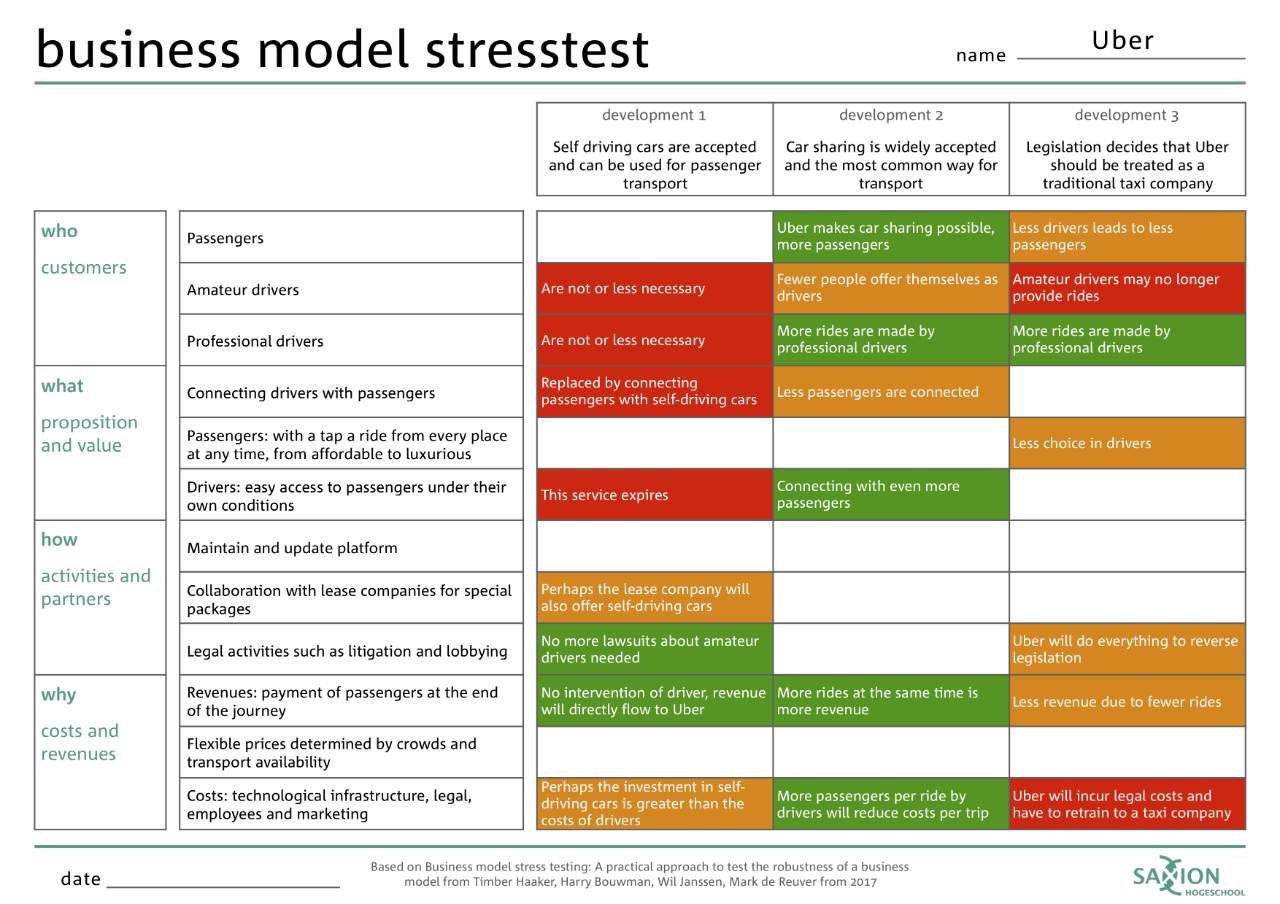Business Model Stress Test

Tips for use
A Business Model Stresstest is most effective when you use it in a group. The group should consist of people who are familiar with your company. You can also involve (external) experts.
Print the Business Style Stresstest on a large poster. For inspiration have a look at Uber‘s Stresstest.
How to use
In the Business Model Stresstest you investigate if your company can withstand developments in the areas of politics, economy, society, technology, market or regulation. Examples are aging of the population and big economic growth. Map your company’s strengths and weaknesses through the following steps.
Step 1: describe your company
Describe the most important elements of your company through answering the Who, What, How and Why questions.
Who - customers
Who buy your products or services? Give a brief description of your customer(s).
What - proposition and value
Which product or service does your company offer? Describe and explain the problem it solves for your customers. Also, which advantages does your product or service have over the competitors offering?
How - activities and partners
Describe how your product or service is made. Which activities need to take place to get your product or service to the customer? Think for example of machines and personnel that are vital to the making of your product or service. Who are the partners that make the product or service possible?
Why - costs and revenues
What are the biggest expenses? Describe those parts of the company or your product that cost the most money. Than look at your earnings. What is your revenue model? Do you earn money only by selling the product or service, do you have other sources of income?
Step 2: select the three important developments
There are countless developments affecting your business. Think of trends or upcoming changes in your market. Look at the following topics and consider which are relevant for your company.
- Politics: laws and regulations, political stability, and trade agreements or restrictions;
- Economy: economic growth, interest rates, inflation, exchange rates;
- Social: culture, health, population growth, age distribution, work ethics;
- Technology: innovation, developments, new hardware (computers, telephones, tablets), new software;
- Environment: weather, climate, environmental awareness.
Write down the three most important developments for your company. Choose the developments that you think will have the most impact on your business. Of course, you can also only choose one or two developments.
Step 3: confront your company with the developments
Now confront your company with the developments you have chosen. Check for each element of the Who, What, How and Why of your company if a development has an impact. See if the impact is negative or positive. Use the following indicators to get a clear view of the impact of the development.
- Red: indicates that this part of your company is no longer viable. In this case, the development is a danger to the part of the company. If the development happens this element of the company can no longer exist.
- Orange: indicates that this part is no longer profitable. In this case, the development ensures that the element of your company needs to change.
- Green: indicates that this element of your company is strengthened by the development.
- White: there is little to no impact.
Step 4: strengths and weaknesses of your company
Look at the canvas. How does the confrontation between the developments and your company look?
Where are the strengths? These are the places that you coloured green. These parts of your company are well organized if the developments take place.
Where are weak points? These are the spots coloured orange and red. Ask yourself how the developments affect your business? Particularly if you find that one specific element of your company is red for different developments. This shows you that this part of your business is a weak spot.
Step 5: make your business more robust
Think of concrete actions that mitigate or even resolve the negative impact. This will make your business more robust. To help you to formulate concrete actions, have a second look at the arguments you used for choosing to colour the element red or orange. Make a list of the actions needed to make your business more robust.